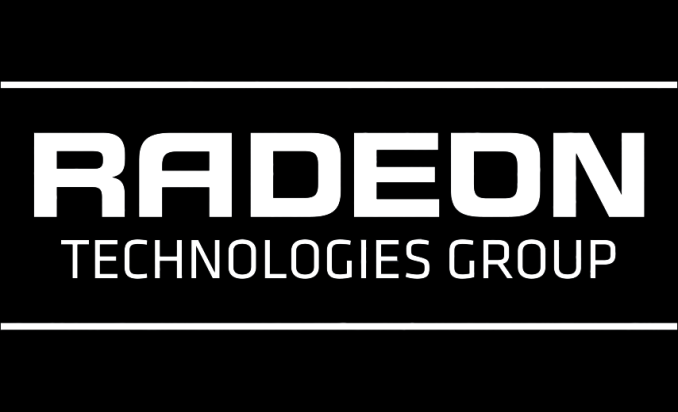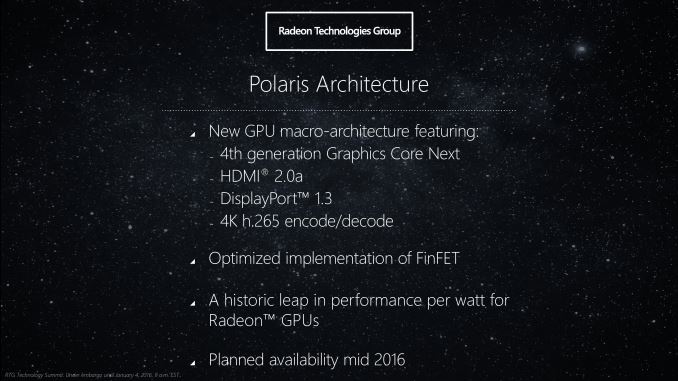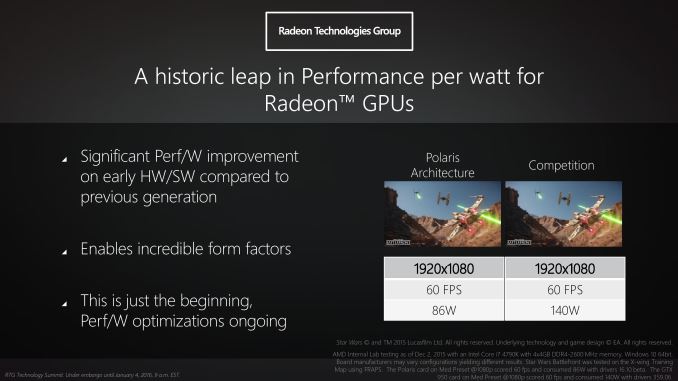AMD Reveals Polaris GPU Architecture: 4th Gen GCN to Arrive In Mid-2016
by Ryan Smith on January 4, 2016 9:00 AM EST
For much of the last month we have been discussing bits and pieces of AMD’s GPU plans for 2016. As part of the Radeon Technology Group’s formation last year, the leader and chief architect of the group, Raja Koduri, has set about to make his mark on AMD’s graphics technology. Along with consolidating all graphics matters under the RTG, Raja and the rest of the RTG have also set about to change how they interact with the public, with developers, and with their customers.
One of those changes – and the impetus for these recent articles – has been that the RTG wants to be more forthcoming about future product developments. Traditionally AMD always held their cards close to their chest about architectures, keeping them secret until the first products based on a new architecture launch (and even then sometimes not talking about matters in detail). With the RTG this is changing, and similar to competitors Intel and NVIDIA, the RTG wants to prepare developers and partners for new architectures sooner. As a result the RTG has been giving us a limited, high-level overview of their GPU plans for 2016.
Back in December we started things off talking about RTG’s plans for display technologies – DisplayPort, HDMI, Freesync, and HDR – and how the company would be laying the necessary groundwork in future architectures to support their goals for higher resolution displays, more ubiquitous Freesync-over-HDMI, and the wider color spaces and higher contrast of HDR. The second of RTG’s presentations that we covered was focused on their software development plans, including Linux driver improvements and the consolidation of all of RTG’s various GPU libraries and SDKs under the GPUOpen banner, which will see these resources released on GitHub as open source projects.
Last but not least among RTG’s presentations is without a doubt the most eagerly anticipated subject: the hardware. As RTG (and AMD before them) has commented on in the past couple of years, a new architecture is being developed for future RTG GPUs. Dubbed Polaris (the North Star), RTG’s new architecture will be at the heart of their 2016 GPUs, and is designed for what can now be called the current-generation FinFET processes. Polaris incorporates a number of new technologies, including a 4th generation Graphics Core Next design for the heart of the GPU, and of course the new display technologies that RTG revealed last month. Finally, the first Polaris GPUs should be available in mid-2016, or roughly 6 months from now.
First Polaris GPU Is Up and Running
But before we dive into Polaris and RTG’s goals for the new architecture, let’s talk about the first Polaris GPUs. With the first products expected to launch in the middle of this year, to no surprise RTG has their first GPUs back from the fab and up & running. To that end – and I am sure many of you are eager to hear about – as part of their presentation RTG showed off the first Polaris GPU in action, however briefly.
As a quick preface here, while RTG demonstrated a Polaris based card in action we the press were not allowed to see the physical card or take pictures of the demonstration. Similarly, while Raja Koduri held up an unsoldered version of the GPU used in the demonstration, again we were not allowed to take any pictures. So while we can talk about what we saw, at this time it’s all we can do. I don’t think it’s unfair to say that RTG has had issues with leaks in the past, and while they wanted to confirm to the press that the GPU was real and the demonstration was real, they don’t want the public (or the competition) seeing the GPU before they’re ready to show it off. That said, I do know that RTG is at CES 2016 planning to recap Polaris as part of AMD’s overall presence, so we may yet see the GPU at CES after the embargo on this information has expired.
In any case, the GPU RTG showed off was a small GPU. And while Raja’s hand is hardly a scientifically accurate basis for size comparisons, if I had to guess I would wager it’s a bit smaller than RTG’s 28nm Cape Verde GPU or NVIDIA’s GK107 GPU, which is to say that it’s likely smaller than 120mm2. This is clearly meant to be RTG’s low-end GPU, and given the evolving state of FinFET yields, I wouldn’t be surprised if this was the very first GPU design they got back from Global Foundries as its size makes it comparable to current high-end FinFET-based SoCs. In that case, it could very well also be that it will be the first GPU we see in mid-2016, though that’s just supposition on my part.
For their brief demonstration, RTG set up a pair of otherwise identical Core i7 systems running Star Wars Battlefront. The first system contained an early engineering sample Polaris card, while the other system had a GeForce GTX 950 installed (specific model unknown). Both systems were running at 1080p Medium settings – about right for a GTX 950 on the X-Wing map RTG used – and generally hitting the 60fps V-sync limit.
The purpose of this demonstration for RTG was threefold: to showcase that a Polaris GPU was up and running, that the small Polaris GPU in question could offer performance comparable to GTX 950, and finally to show off the energy efficiency advantage of the small Polaris GPU over current 28nm GPUs. To that end RTG also plugged each system into a power meter to measure the total system power at the wall. In the live press demonstration we saw the Polaris system average 88.1W while the GTX 950 system averaged 150W. Meanwhile in RTG’s own official lab tests (and used in the slide above) they measured 86W and 140W respectively.
Keeping in mind that this is wall power – PSU efficiency and the power consumption of other components is in play as well – the message RTG is trying to send is clear: that Polaris should be a very power efficient GPU family thanks to the combination of architecture and FinFET manufacturing. That RTG is measuring a 54W difference at the wall is definitely a bit surprising as GTX 950 averages under 100W to begin with, so even after accounting for PSU efficiency this implies that power consumption of the Polaris video card is about half that of the GTX 950. But as this is clearly a carefully arranged demo with a framerate cap and a chip still in early development, I wouldn’t read too much into it at this time.












153 Comments
View All Comments
ASEdouardD - Tuesday, January 5, 2016 - link
It's far from my main concern, but power-performance does impact the experience. I love the fact that NVidia's GPUs are less power hungry and generate less heat at the moment than AMD gpus. It generally makes for quieter and more overclockable cards.grant3 - Monday, January 11, 2016 - link
As an 'enthusiast hobbyist', I like to build fanless computers. In such a situation, performance:watt is the primary constraint on gaming performance.I'm not sure what your list looks like, but IMO "$:Performance" should be a lower priority than power consumption for 'enthusiast gamers', simply because more heat puts physical constraints on how powerfully a system can perform.
pugster - Monday, January 4, 2016 - link
Despite that AMD and Nvidia being stuck on 28nm, Nvidia was able to make decent mobile GPU's via Maxwell. AMD just didn't bother to concentrate their efforts in mobile and low powered GPU's.looncraz - Tuesday, January 5, 2016 - link
AMD had a significant investment to move onward with 20nm and was unable to backport all of the features and improvements due to time and staffing limitations. nVidia, meanwhile, was able to throw more manpower at the situation to handle the situation much more gracefully.AMD's next issue was an underestimation of nVidia's performance improvement, which resulted in AMD's need to push the clockrates on their GPUs beyond the peak efficiency band. You can get ~80% of the performance of a GCN card at about half the power consumption, which the R9 Nano illustrates wonderfully. If AMD's estimate had been accurate, we'd be viewing things differently:
Imagine the 7970 releasing at 800Mhz and overclocking to 1.1GHz, and the R9 290/X having a base clock of 850MHz, and hitting 1.2GHz... Changes the dynamic entirely. nVidia outperformed expectations, AMD delivered exactly what was expected... then had to push to match nVidia.
Scopezz - Friday, January 8, 2016 - link
Best Analysis ever. +1zodiacfml - Wednesday, January 6, 2016 - link
Good for smaller devices (and I'm excited) but I doubt the high-end. It may use less power but the performance might only be a small increment over the previous high-end GPUsNinhalem - Monday, January 4, 2016 - link
I'm looking forward to what improvements the Polaris family will make to HBM on the unannounced high end cards.Shadow7037932 - Monday, January 4, 2016 - link
Indeed. I'm thinking they'll likely increase capacity to say 6-8GB as 4GB can start to become limiting especially at very high resolutions.jjj - Monday, January 4, 2016 - link
You are killing me with the RTG, stop saying it every 4 words.....jjj - Monday, January 4, 2016 - link
30 times on page 1, 41 times on page 2 and 24 times on page 3the article is unreadable